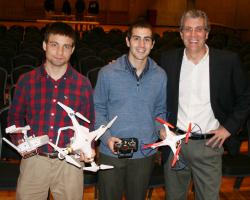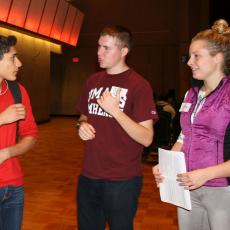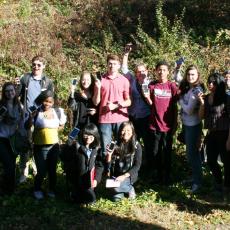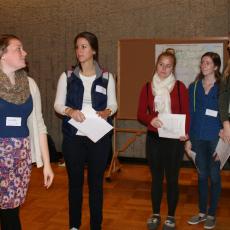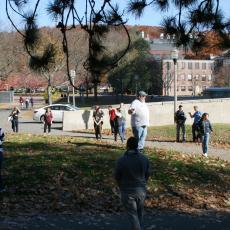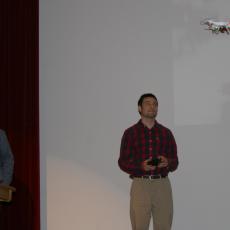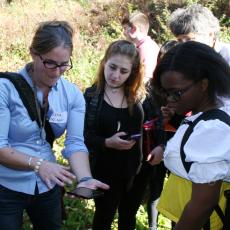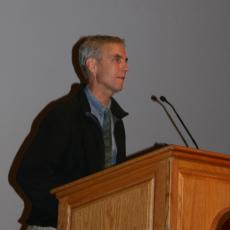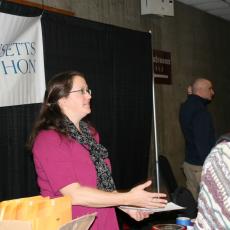The 29th annual Massachusetts Envirothon kicked off in high gear on November 4 at the University of Massachusetts Amherst campus. Over 200 high school students from 22 Massachusetts communities gathered to attend myriad workshops led by UMass professors, graduate students and leaders in the environment from organizations throughout the state.
The Envirothon is Massachusetts’ leading natural resource education program for high school students, emphasizing hands-on, team-oriented problem-solving and community involvement that prepares young people for environmental careers and active citizenship.
Every year, a different topic is chosen as the focal point. For 2016, “invasive species” is the specific area of concentration. Students will learn how to identify invasive plants and insects and what constitutes a successful restoration project. They will learn how to address future invasive species and come to understand the relationship of invasive plants and insects to the expected effects of climate change.
Unmanned Aerial Vehicles (‘drone’ by any other name)
Of the 26 workshops offered, one on Unmanned Aerial Vehicles (UAVs-aka, drones), was a hot topic. Attendees learned that UAVs are being used by UMass as a very useful tool to monitor invasive species in Westfield to map out water chestnut infestation. UMass works in partnership with an education business, Trillium Learning, on this project. Charles Schweik, Professor of Environmental Conservation, along with graduate students, Ryan Wicks and Seth Engelbourg, presented a demonstration on how UAVs can be used safely for extensive applications.
Today, this technology is used in the following ways: damage assessment after hurricanes, forest fire fighting monitors, search and rescue missions and invasive species monitoring. In Alaska, a UAV is employed to monitor debris from the 2011 Japanense tsunami as they look for invasive species which might be carried across the Pacific ocean. Schweik acknowledged that this technology is still considered the “wild west.” The Federal Aviation Administration (FAA) has yet to release regulations regarding safe use of UAV’s. For now, UMass takes the task of responsible training seriously with safety their number one priority (never flying over people and always maintaining a line of sight). Schweik also remarked that new job opportunities may arise from UAV piloting which is especially exciting in areas that include environmental applications. Among collegiate level use of UAVs, the University of Massachusetts is a national leader.
Outsmart invasive species with your Smartphone
A very accessible high tech opportunity to become a citizen scientist lies in the palm of your hand. A new app called “Outsmart” can be used to identify and report invasives to a statewide database with your own smartphone. How to get smart? Download OUTSMART from itunes® or Google Playstore. Lena Fletcher, lecturer, UMass Department of Environmental Conservation suggests for more information and reporting, click here.
Related issues for Envirothon students
Sustainability was effectively demonstrated by Professor Paul Barten, Department of Environmental Conservation, who shared photographs and stories of his annual trek to Northern Quebec. Each year Barten teaches a unique course entitled, “Cree Culture, Natural Resources and Sustainability.” During spring break, his class heads north to live in a Cree winter village where they are immersed in nature and culture as they experience a sense of place. Central tenets of conservation and sustainability become evident as students learn how 250 generations of Cree people have learned to live lightly on the land.
Workshops on tree identification, groundwater contamination, soils overview and updates on invasive pests were among supportive educational opportunities for students. All teams will come together in May at the annual Massachusetts Envirothon competition (held at the Hopkinton State Park) to demonstrate what they’ve learned about invasive species and important environmental issues. The winner of this competition will go on to compete in the North American Envirothon July 24-29, 2016 in Peterborough, Ontario, Canada.
